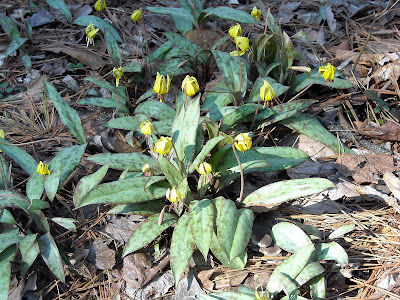Tuesday, March 10, 2009
Trout Lilies at Duke Garden
Last week I made a trip to North Carolina and plan to regale you with photos of that trip over the next few days. This picture is of Erythronium americana, trout lily, that was growing in the Duke Gardens native area, also known as the Bloomquist Garden. Trout lilies, also known as dogtooth violets (no relation to violets),are among the earliest wildflowers to bloom. Mine are up, but if I was going to get any blooms, they would already have bloomed.I rarely get more than one or two flowers when they do bloom, certainly not a big bouquet like this one. Unfortunately, this is the typical case for me, so I decided to check up on how to grow them. The information I found may explain why I get so few flowers from them.
Trout lilies do not bloom until they produce two leaves, which can take several years. The key to my non-success may lie in the fact that these lilies do not bloom til they reach a depth in the ground of 10 to 20 cm or 4 to 8 inches. The trout lilies I have came to me as hitchhikers in some soil on plants that were moved from a friend's woodland garden. I saw there were some tiny bulbs in the soil, so rather than plant them, I simply dumped the soil on the surface. All these years later, they are still trying to pull themselves lower in the earth.
A few of the growing conditions I did have right- shady area under deciduous trees in moist(?) woodland soil.The plants need sun in the early spring when the leaves are photosynthesizing, but the leaves die back and retreat to the cool earth near the time when the trees leaf out. If they are fertilized at all, compost should be used.
This is a small plant, not more than 3 or 4 inches tall at max. If you click on the image you should get enough enlargement to take a better look.
Subscribe to:
Post Comments (Atom)



No comments:
Post a Comment